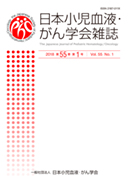Volume 60, Issue 3
Displaying 1-19 of 19 articles from this issue
- |<
- <
- 1
- >
- >|
The 64th Annual Meeting of the Japanese Society of Pediatric Hematology / Oncology
-
2023Volume 60Issue 3 Pages 169
Published: 2023
Released on J-STAGE: September 28, 2023
Download PDF (612K) -
2023Volume 60Issue 3 Pages 170-172
Published: 2023
Released on J-STAGE: September 28, 2023
Download PDF (1438K) -
2023Volume 60Issue 3 Pages 173-178
Published: 2023
Released on J-STAGE: September 28, 2023
Download PDF (2862K) -
2023Volume 60Issue 3 Pages 179-185
Published: 2023
Released on J-STAGE: September 28, 2023
Download PDF (6591K) -
2023Volume 60Issue 3 Pages 186-191
Published: 2023
Released on J-STAGE: September 28, 2023
Download PDF (24290K)
-
2023Volume 60Issue 3 Pages 192-198
Published: 2023
Released on J-STAGE: November 03, 2023
Download PDF (2296K)
-
2023Volume 60Issue 3 Pages 199-206
Published: 2023
Released on J-STAGE: November 03, 2023
Download PDF (3549K) -
2023Volume 60Issue 3 Pages 207-213
Published: 2023
Released on J-STAGE: November 03, 2023
Download PDF (3087K) -
2023Volume 60Issue 3 Pages 214-219
Published: 2023
Released on J-STAGE: November 03, 2023
Download PDF (3481K)
-
2023Volume 60Issue 3 Pages 220-227
Published: 2023
Released on J-STAGE: November 03, 2023
Download PDF (1311K)
-
2023Volume 60Issue 3 Pages 228-233
Published: 2023
Released on J-STAGE: November 03, 2023
Download PDF (1028K) -
2023Volume 60Issue 3 Pages 234-236
Published: 2023
Released on J-STAGE: November 03, 2023
Download PDF (782K)
-
Proton beam therapy combined with surgical bioabsorbable spacer placement for pediatric malignancies2023Volume 60Issue 3 Pages 237-240
Published: 2023
Released on J-STAGE: November 03, 2023
Download PDF (3527K)
-
Navigating pediatric renal tumors: A historical overview of clinical research and practical insights2023Volume 60Issue 3 Pages 241-247
Published: 2023
Released on J-STAGE: November 03, 2023
Download PDF (959K)
-
2023Volume 60Issue 3 Pages 248-252
Published: 2023
Released on J-STAGE: November 03, 2023
Download PDF (2436K)
Review Article
-
2023Volume 60Issue 3 Pages 253-259
Published: 2023
Released on J-STAGE: November 03, 2023
Download PDF (2422K)
Case Report
-
2023Volume 60Issue 3 Pages 260-265
Published: 2023
Released on J-STAGE: November 03, 2023
Download PDF (845K) -
2023Volume 60Issue 3 Pages 266-269
Published: 2023
Released on J-STAGE: November 03, 2023
Download PDF (1070K)
Report
-
2023Volume 60Issue 3 Pages 270-275
Published: 2023
Released on J-STAGE: November 03, 2023
Download PDF (6408K)
- |<
- <
- 1
- >
- >|
